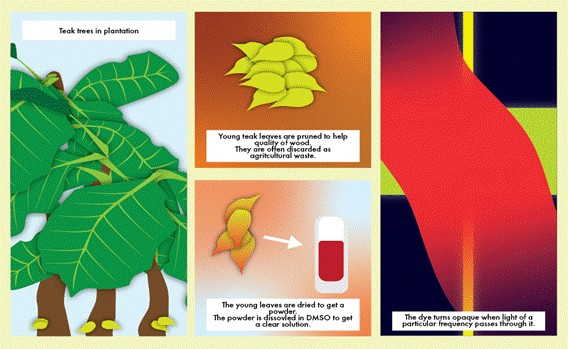Teak Leaf Extract Shows Promise for Eco-Friendly Laser Protection Technology
The research emphasized not only scientific innovation but also sustainability and waste valorization—an increasingly critical focus in material sciences.

- Country:
- India
In a significant leap for sustainable photonic materials, scientists at the Raman Research Institute (RRI), Bengaluru, have discovered that an extract from teak leaves—typically considered agricultural waste—can offer reliable protection against high-power laser radiation. This breakthrough holds tremendous promise for safeguarding human eyes and delicate optical sensors in sectors ranging from healthcare to defence.
This novel research, funded by the Department of Science and Technology (DST), Government of India, and recently published in the Journal of Photochemistry and Photobiology A: Chemistry, opens the door to developing biodegradable, cost-effective, and eco-friendly laser safety equipment using naturally available pigments.
The Laser Threat in Modern Times
As laser technologies evolve rapidly and permeate critical applications such as surgical tools, precision cutting equipment, and military-grade targeting systems, the potential for accidental exposure to intense laser beams has risen sharply. Unchecked, such exposure can lead to severe eye injuries and impair the performance of sensitive photonic components.
In this context, the search for effective optical limiting materials—that is, substances that can adapt to absorb more light as its intensity increases—is both timely and essential. These materials play a pivotal role in regulating laser intensity to prevent damage to human and machine vision systems.
Teak Leaves: From Agricultural Waste to Optical Goldmine
Led by Dr. Beryl C, a DST Women Scientist in the Light and Matter Physics theme at RRI, the research team turned their attention to teak (Tectona grandis L.f) leaves, which are often discarded after harvest. These leaves are notably rich in anthocyanins, naturally occurring pigments that lend them a reddish-brown hue.
“Teak leaves are a rich source of natural pigments such as anthocyanin. Recognizing this, we aimed to explore their potential as a non-toxic, biodegradable, and economically viable alternative to synthetic dyes in nonlinear optics,” explained Dr. Beryl.
The research emphasized not only scientific innovation but also sustainability and waste valorization—an increasingly critical focus in material sciences.
The Science Behind the Discovery
To tap into the optical power of teak leaves, the researchers followed a meticulous preparation process:
-
Drying and Powdering: Freshly collected teak leaves were first dried and ground into fine powder.
-
Solvent Extraction: The powdered material was then soaked in a suitable solvent.
-
Ultrasonication and Centrifugation: These purification steps ensured the extraction of a clean, reddish-brown dye.
This natural dye was subjected to laser light at two intensities—steady (continuous wave) and pulsed—mimicking real-world scenarios in medical and industrial settings.
Using advanced optical experiments such as Z-Scan and Spatial Self-Phase Modulation (SSPM), the team discovered that the dye exhibits Reverse Saturable Absorption (RSA)—a key property for optical limiters. Unlike saturable absorbers that allow more light through at higher intensities, RSA materials absorb more light as intensity increases. This dynamic absorption is essential for laser safety applications.
Eco-Friendly Alternative to Toxic Synthetics
Until now, the most widely used optical limiters have relied on complex and often hazardous materials such as graphene, carbon nanotubes, fullerenes, and metallic nanoparticles. Not only are these expensive, but their environmental impact—from energy-intensive synthesis processes to potential toxicity—is a growing concern.
In contrast, teak leaf extract offers a sustainable and earth-friendly alternative. It is easy to obtain, biodegradable, and requires minimal processing, making it ideal for scalable green technologies. The added advantage of compostability makes it a standout solution in the push for circular economy principles in material science.
Applications and Future Prospects
The implications of this discovery are far-reaching. With further refinement, teak leaf-based optical limiters could be used in:
-
Laser Safety Goggles: Protecting surgeons, scientists, and technicians from accidental laser flashes.
-
Optical Sensor Shields: Guarding sensitive components in military and aerospace instruments.
-
Photonic Coatings: Applying protective layers on glass and optical fibers.
Moving forward, researchers plan to focus on enhancing the stability and durability of the dye, developing methods to integrate it into commercial products, and exploring other underutilized botanical sources for similar properties.
Toward Greener Optics
This breakthrough represents a convergence of traditional ecological knowledge and cutting-edge science. It points to a future where photonic technologies—often criticized for their environmental footprint—can align with sustainability goals.
By transforming humble teak leaves into a powerful tool for laser protection, the team at RRI has not only addressed a modern-day challenge but also provided a model for leveraging natural resources in high-tech applications. With continued investment and innovation, India could soon lead the world in the development of biodegradable optical materials for a safer and greener technological landscape.










